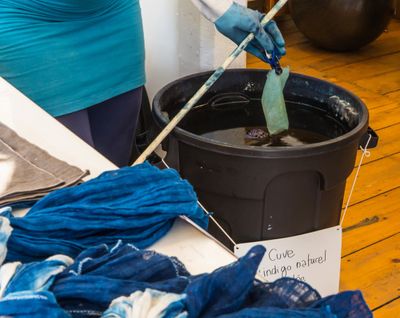About Indigo Plant Dye
Indigo dyeing has been around for several thousands of years. Making indigo plant dye requires a fermentation process that causes a magical color change. The primary plants used to make indigo are woad and Japanese indigo, but there are a couple of lesser known sources. Whichever plant you acquire, there are numerous steps to making the dye. Indigo is said to be the oldest dye, with cloth in the hue found in Egyptian pyramids. Ancient civilizations used indigo as more than a fabric dye. They used it in cosmetics, paint, crayons, and more. It takes at least 100 pounds (45 kg.) to make 4 ounces (113 g.) of dye. This made it a very valuable commodity. The process encompasses 6 steps: ferment, alkalize, aerate, concentrate, strain, and store. The initial process must be done without the presence of oxygen, which causes the blue color to arrive too early. It is also necessary to have fairly warm temperatures to encourage the fermentation process.
Making Indigo Plant Dye
First, you need to gather a lot of the indigo producing plants. Once you have a lot of cut stems, pack them tightly into a dark colored plastic tub. Add water to cover the stems and weight them down with mesh topped with stones. Cover the tub and allow fermentation to take place over 3 to 5 days. After the time is up, remove the stems and leaves. Next, you add 1 teaspoon (3.5 g.) per gallon (4 L.) of slaked lime. This makes the solution alkaline. Then you need to whip the infant dye. It will get foamy, then turn blue, but it’s not done until it is an ugly, reddish-brown hue. Then you settle the sediment and skim off the concentrate at the top. Strain it several times and it is ready for immediate indigo dyeing or store for a year in glass bottles. You can also dry the pigment and it will last indefinitely.
How to Dye with Indigo Plants
Once you have your pigment, dyeing with indigo is straightforward. You can choose to make patterns by adding something that resists the dye such as string (tie dye), wax, or other items that will prevent dye from coloring the fabric. The dye is prepared by mixing:
0.35 ounces (10 grams) indigo 0.71 ounces (20 grams) soda ash 1 ounce (30 grams) sodium hydrosulfite 1.3 gallons (5 liter) water 2 pounds (1 kg.) fabric or yarn
You will need to slowly temper the soda ash and indigo dye with water so it is liquid enough to add to the vat. Boil the remaining water and slowly stir in the other ingredients. Use metal tools and gloves as you dip your fabric. Repeated dips will result in darker blue tones. Let the garment dry. The blue tones created by indigo plant dye are unique and much more earth friendly than synthetic dyes.
